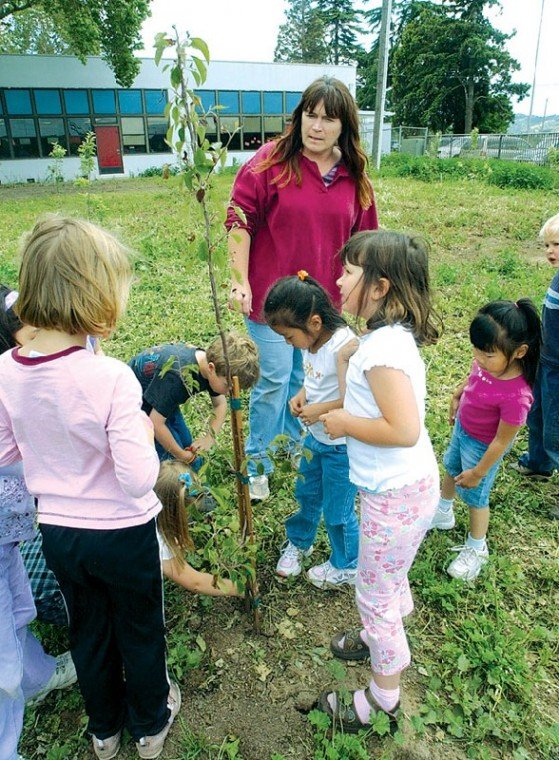Listening to a teacher in a classroom drone on about the wonders
of beneficial insects is one way to learn. But wouldn’t it be more
fun to put on some gloves, roll up your pant cuffs and dig into the
dirt?
Listening to a teacher in a classroom drone on about the wonders of beneficial insects is one way to learn. But wouldn’t it be more fun to put on some gloves, roll up your pant cuffs and dig into the dirt?
That’s the case for several South Valley students who are learning the biology of gardening in the most practical way: hand-raising vegetables, flowers and plants in gardens right outside their schools.
Hollister’s Sunnyslope and R.O. Hardin elementary schools, Morgan Hill’s Oakwood Country School and Charter School of Morgan Hill and Gilroy High School are a few places where students cultivate gardens from beginning to end.
Often, being able to touch the dirt, plant the seeds and watch the results of their labor almost makes students forget they’re learning, said Meghan Browne, a middle school science teacher at Oakwood.
“The kids get so excited to go outside,” she said. “Having a garden creates a sense of ownership. They care so much about what’s going on. We talk about photosynthesis in the classroom, but actually going out and seeing how it works, I think, makes it make more sense.”
Every class at Oakwood, from preschool to eighth grade, has its own garden. There are 30 gardens total, and each one is about 30 feet by 20 feet, roughly the same size as a classroom.
This year, Browne’s students – all 100 of them – are doctoring seven of the gardens that have plants that are withering and dying. The students sought donations, ordered and measured soil, pulled weeds and began planting new seeds about six weeks ago, Browne said.
Among the expected crops are watermelon, kale, cabbage, celery, lettuce and peppers, as well as flowers such as snapdragons, daisies and xenias.
“It’s definitely learning in a different way,” said seventh-grader Nathan Campeau, who had tried gardening on his own in the past, albeit unsuccessfully. “It’s a more fun way to learn than just sitting around with a book in front of you. … We learned how to plant and water the plants, and we learned interesting ways to find out how much space each plant needs to grow. Mostly, we learned that if we had a bad experience planting them too close together.”
In Heather Nolan’s horticultural class at GHS, students learn more advanced gardening concepts such as the low use of pesticides, seed propagation and integrated pest management.
One component of the class requires students to choose a plant and grow, market and sell it. Another project has students working in teams to keep a plot of land in tip-top shape. Much of the hands-on work is done in the high school’s on-campus greenhouse.
“I think the students like getting out there and using their hands,” Nolan said. “I can tell them, ‘We can do grafting like this,’ and show them a picture or slides or a transparency, but actually doing it makes a whole world of difference.”
The garden at Sunnyslope got its start about 10 years ago as a way to reach students who were limited in English, said third-grade teacher Shelley Geisler, who has been involved with the garden since its inception.
Then-principal Mary Guerro spearheaded the project as a way to reach students who had a hard time understanding what was being taught in the classroom, Geisler said.
Enthusiasm for the garden quickly spread to other students.
Now, students in the kindergarten through fifth grade participate in such activities as drawing flowers, journaling observations and, of course, planting. The garden – which is referred to around school as the outdoor classroom or living laboratory, Geisler said – includes roses, cacti, a butterfly garden, mint, grapes, honeysuckle and sunflowers. Last week, the students planted tomatoes, squash, onions and peppers.
About 10 to 15 minutes daily are spent in the garden observing and taking notes. Every Thursday, students wear old shoes and clothes and bring gloves so they can plant, weed and otherwise get their hands dirty.
Twice a year the school holds a garden work day, where students, parents and teachers spend four hours on a Saturday pruning the garden and pulling weeds.
Along with learning gardening basics, students also learn how to work together, handle tools safely and behave orderly in a non-classroom setting.
Geisler said some of her students who generally are low-performing in the classroom particularly enjoy the garden, probably because they’re able to use their hands to help them learn, she said.
“They feel very successful out there. They’re working with their hands. You give them a tool or some seeds to plant, and when you look at them out there, they just shine,” she said. “They have the biggest smiles on their faces. It’s a much different experience than being in a classroom.”












